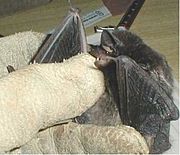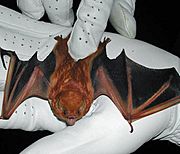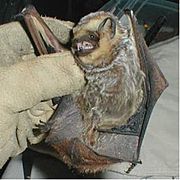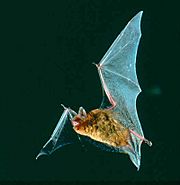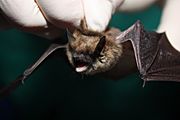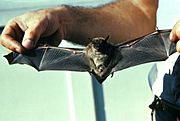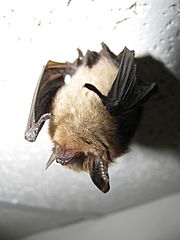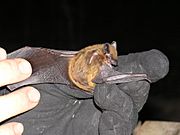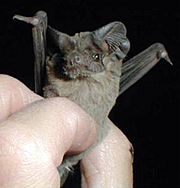List of mammals of Alabama facts for kids
The State of Alabama is home to many amazing mammal species. These are animals that have fur or hair, are warm-blooded, and feed their babies milk. Historically, Alabama had one armadillo species, sixteen bat species, thirteen carnivore species (meat-eaters), six insectivore species (insect-eaters), one opossum species, four rabbit species, twenty-two rodent species, and three ungulate species (hoofed animals).
Sadly, four of these native species no longer live in Alabama. They have become extirpated, meaning they disappeared from the state. These are the American bison, cougar, red wolf, and the elk.
Alabama also has six introduced mammal species. These are animals that were brought to the state by humans, either on purpose or by accident. They include the black rat, brown rat, fallow deer, wild boar, house mouse, and nutria.
Humans have greatly impacted many mammal species. Things like hunting and destroying natural homes (called habitat destruction) have put several species at risk. The Alabama Department of Conservation and Natural Resources keeps track of how worried they are about each species. They rank them from "lowest concern" to "highest concern."
Contents
- Armadillos: Armored Animals
- Bats: Flying Mammals of Alabama
- Carnivores: Alabama's Meat-Eaters
- Shrews and Moles: Tiny Mammals of Alabama
- Opossums: North America's Only Marsupial
- Rabbits: Hopping Through Alabama
- Rodents: Diverse Small Mammals
- Cetaceans: Whales and Dolphins in Alabama's Waters
- Ungulates: Hoofed Mammals
Armadillos: Armored Animals
Armadillos are unique mammals known for their tough, bony shells. They are mostly active at night and dig for insects and other small creatures.
| Image | Scientific name | Common name | Family | Conservation concern |
|---|---|---|---|---|
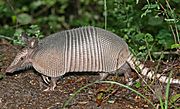 |
Dasypus novemcinctus | nine-banded armadillo | Dasypodidae | Low |
Bats: Flying Mammals of Alabama
Bats are the only mammals that can truly fly! They are very important for controlling insects and pollinating plants. Alabama is home to many different kinds of bats.
Carnivores: Alabama's Meat-Eaters
Carnivores are mammals that primarily eat meat. This group includes a variety of animals, from foxes to bears and even wild cats.
| Image | Scientific name | Common name | Family | Conservation concern |
|---|---|---|---|---|
 |
Canis latrans | coyote | Canidae | Lowest |
 |
Canis rufus | red wolf | Canidae | Extirpated |
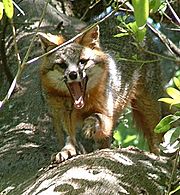 |
Urocyon cinereoargenteus | gray fox | Canidae | Lowest |
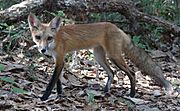 |
Vulpes vulpes | red fox | Canidae | Lowest |
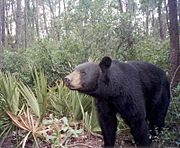 |
Ursus americanus | American black bear | Ursidae | Highest |
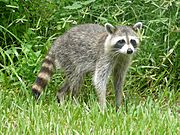 |
Procyon lotor | raccoon | Procyonidae | Lowest |
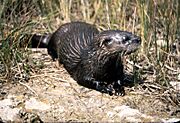 |
Lontra canadensis | North American river otter | Mustelidae | Low |
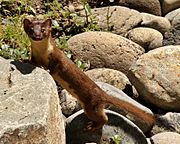 |
Neogale frenata | long-tailed weasel | Mustelidae | High |
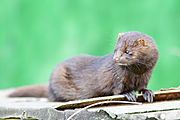 |
Neogale vison | American mink | Mustelidae | Low |
 |
Mephitis mephitis | striped skunk | Mephitidae | Low |
 |
Spilogale putorius | eastern spotted skunk | Mephitidae | High |
 |
Lynx rufus | bobcat | Felidae | Lowest |
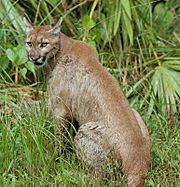 |
Puma concolor | cougar | Felidae | Extirpated |
The American black bear is Alabama's state land mammal. It mostly lives in northeast Alabama and the Mobile-Tensaw River Delta.
Shrews and Moles: Tiny Mammals of Alabama
This group includes small, often unseen mammals like shrews and moles. Shrews are tiny, mouse-like creatures with long snouts, while moles are known for digging tunnels underground.
| Image | Scientific name | Common name | Family | Conservation concern |
|---|---|---|---|---|
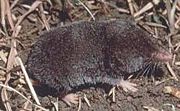 |
Blarina brevicauda | northern short-tailed shrew | Soricidae | Moderate |
 |
Blarina carolinensis | southern short-tailed shrew | Soricidae | Moderate |
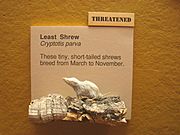 |
Cryptotis parva | North American least shrew | Soricidae | Moderate |
| Sorex hoyi | American pygmy shrew | Soricidae | High | |
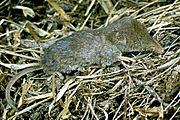 |
Sorex longirostris | southeastern shrew | Soricidae | Moderate |
 |
Scalopus aquaticus | eastern mole | Talpidae | Low |
Opossums: North America's Only Marsupial
The opossum is a unique mammal because it's the only marsupial (pouched mammal) found in North America. Like kangaroos, mothers carry their young in a pouch.
| Image | Scientific name | Common name | Family | Conservation concern |
|---|---|---|---|---|
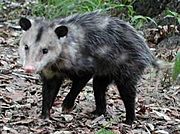 |
Didelphis virginiana | Virginia opossum | Didelphidae | Low |
Rabbits: Hopping Through Alabama
Rabbits are well-known for their long ears, powerful hind legs for hopping, and soft fur. Several species of rabbits live in Alabama's diverse habitats.
| Image | Scientific name | Common name | Family | Conservation concern |
|---|---|---|---|---|
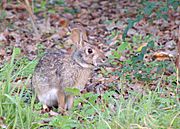 |
Sylvilagus aquaticus | swamp rabbit | Leporidae | Low |
 |
Sylvilagus floridanus | eastern cottontail | Leporidae | Lowest |
 |
Sylvilagus obscurus | Appalachian cottontail | Leporidae | High |
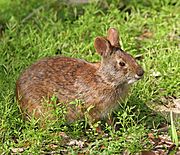 |
Sylvilagus palustris | marsh rabbit | Leporidae | High |
Rodents: Diverse Small Mammals
Rodents are the largest group of mammals, known for their continuously growing front teeth. Alabama has many different kinds of rodents, from tiny mice to larger beavers.
| Image | Scientific name | Common name | Family | Conservation concern |
|---|---|---|---|---|
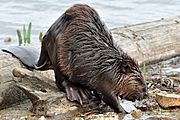 |
Castor canadensis | North American beaver | Castoridae | Lowest |
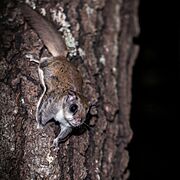 |
Glaucomys volans | southern flying squirrel | Sciuridae | Lowest |
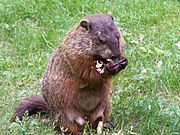 |
Marmota monax | groundhog | Sciuridae | Lowest |
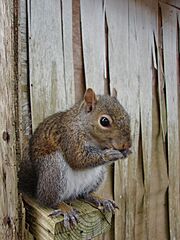 |
Sciurus carolinensis | eastern gray squirrel | Sciuridae | Lowest |
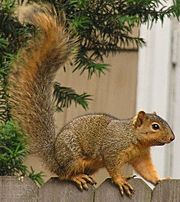 |
Sciurus niger | fox squirrel | Sciuridae | Low |
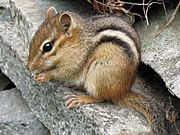 |
Tamias striatus | eastern chipmunk | Sciuridae | Lowest |
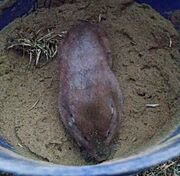 |
Geomys pinetis | southeastern pocket gopher | Geomyidae | High |
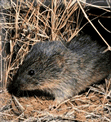 |
Microtus ochrogaster | prairie vole | Cricetidae | Moderate |
 |
Microtus pinetorum | woodland vole | Cricetidae | Low |
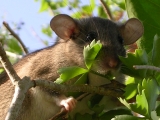 |
Neotoma cinerea | eastern woodrat | Cricetidae | Moderate |
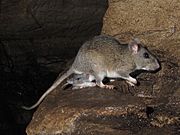 |
Neotoma magister | Allegheny woodrat | Cricetidae | High |
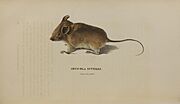 |
Ochrotomys nuttalli | golden mouse | Cricetidae | Lowest |
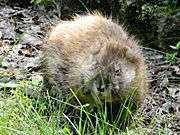 |
Ondatra zibethicus | muskrat | Cricetidae | Lowest |
 |
Oryzomys palustris | marsh rice rat | Cricetidae | Lowest |
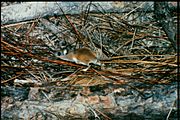 |
Peromyscus gossypinus | cotton mouse | Cricetidae | Lowest |
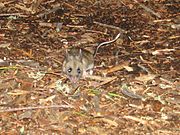 |
Peromyscus leucopus | white-footed mouse | Cricetidae | Lowest |
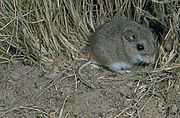 |
Peromyscus polionotus | oldfield mouse | Cricetidae | Moderate |
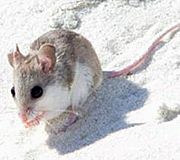 |
Peromyscus polionotus ammobates | Alabama beach mouse | Cricetidae | Highest |
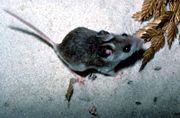 |
Peromyscus polionotus trissyllepsis | Perdido Key beach mouse | Cricetidae | Highest |
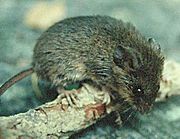 |
Reithrodontomys humulis | eastern harvest mouse | Cricetidae | Moderate |
 |
Sigmodon hispidus | hispid cotton rat | Cricetidae | Lowest |
 |
Mus musculus | house mouse | Muridae | Introduced |
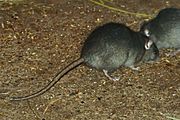 |
Rattus rattus | black rat | Muridae | Introduced |
 |
Rattus norvegicus | brown rat | Muridae | Introduced |
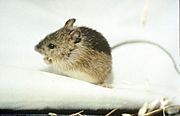 |
Zapus hudsonius | meadow jumping mouse | Dipodidae | High |
 |
Myocastor coypus | nutria | Myocastoridae | Introduced |
The Alabama beach mouse lives only on the Fort Morgan Peninsula and Ono Island in Baldwin County. The Perdido Key beach mouse is found only on Perdido Key in Baldwin County, Alabama and Escambia County, Florida.
Cetaceans: Whales and Dolphins in Alabama's Waters
Cetaceans are marine (ocean-dwelling) mammals like whales and dolphins. While they live in the ocean, many species can be found in the waters off Alabama's coast.
| Image | Scientific name | Common name | Family | Conservation concern |
|---|---|---|---|---|
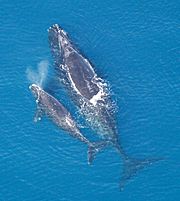 |
Eubalaena glacialis | North Atlantic right whale | Balaenidae | Critically endangered |
 |
Balaenoptera ricei | Rice's whale | Balaenopteridae | Critically endangered |
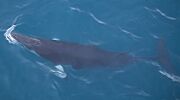 |
Balaenoptera acutorostrata | common minke whale | Balaenopteridae | Least concern |
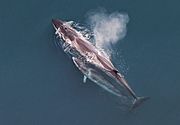 |
Balaenoptera borealis | sei whale | Balaenopteridae | Endangered |
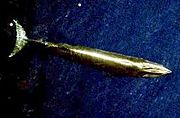 |
Balaenoptera brydei | Bryde's whale | Balaenopteridae | Least concern |
 |
Balaenoptera musculus | blue whale | Balaenopteridae | Endangered |
 |
Balaenoptera physalus | fin whale | Balaenopteridae | Vulnerable |
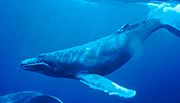 |
Megaptera novaeangliae | humpback whale | Balaenopteridae | Least concern |
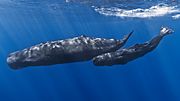 |
Physeter macrocephalus | sperm whale | Physeteridae | Vulnerable |
 |
Kogia breviceps | pygmy sperm whale | Kogiidae | Least concern |
 |
Kogia sima | dwarf sperm whale | Kogiidae | Least concern |
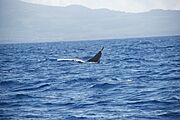 |
Mesoplodon bidens | Sowerby's beaked whale | Ziphiidae | Least concern |
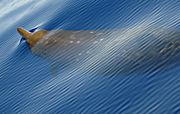 |
Mesoplodon densirostris | Blainville's beaked whale | Ziphiidae | Least concern |
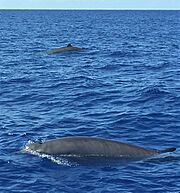 |
Mesoplodon europaeus | Gervais' beaked whale | Ziphiidae | Least concern |
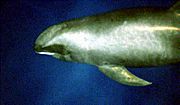 |
Peponocephala electra | melon-headed whale | Ziphiidae | Least concern |
 |
Ziphius cavirostris | Cuvier's beaked whale | Ziphiidae | Least concern |
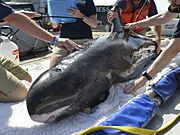 |
Feresa attenuata | pygmy killer Whale | Delphinidae | Least concern |
 |
Globicephala macrorhynchus | short-finned pilot whale | Delphinidae | Least concern |
 |
Grampus griseus | Risso's dolphin | Delphinidae | Least concern |
 |
Lagenodelphis hosei | Fraser's dolphin | Delphinidae | Least concern |
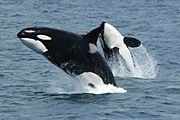 |
Orcinus orca | killer whale | Delphinidae | Data deficient |
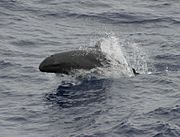 |
Pseudorca crassidens | false killer Whale | Delphinidae | Near threatened |
 |
Stenella frontalis | Atlantic spotted dolphin | Delphinidae | Least concern |
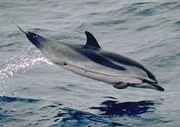 |
Stenella coeruleoalba | striped dolphin | Delphinidae | Least concern |
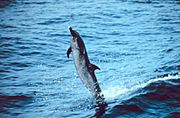 |
Stenella attenuata | pantropical spotted dolphin | Delphinidae | Least concern |
 |
Stenella longirostris | spinner dolphin | Delphinidae | Least concern |
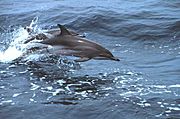 |
Stenella clymene | Clymene dolphin | Delphinidae | Least concern |
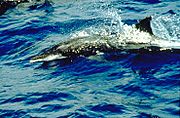 |
Steno bredanensis | rough-toothed dolphin | Delphinidae | Least concern |
 |
Tursiops truncatus | common bottlenose dolphin | Delphinidae | Least concern |
Ungulates: Hoofed Mammals
Ungulates are mammals that have hooves. This group includes large animals like deer and the wild boar.
| Image | Scientific name | Common name | Family | Conservation concern |
|---|---|---|---|---|
 |
Bison bison | American bison | Bovidae | Extirpated |
 |
Cervus canadensis | elk | Cervidae | Extirpated |
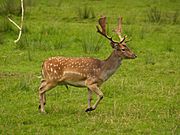 |
Dama dama | fallow deer | Cervidae | Introduced |
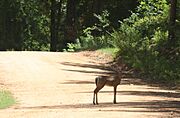 |
Odocoileus virginianus | white-tailed deer | Cervidae | Lowest |
 |
Sus scrofa | wild boar | Suidae | Introduced |
Elk were reintroduced to Alabama in the 1920s, but this effort was not successful.




